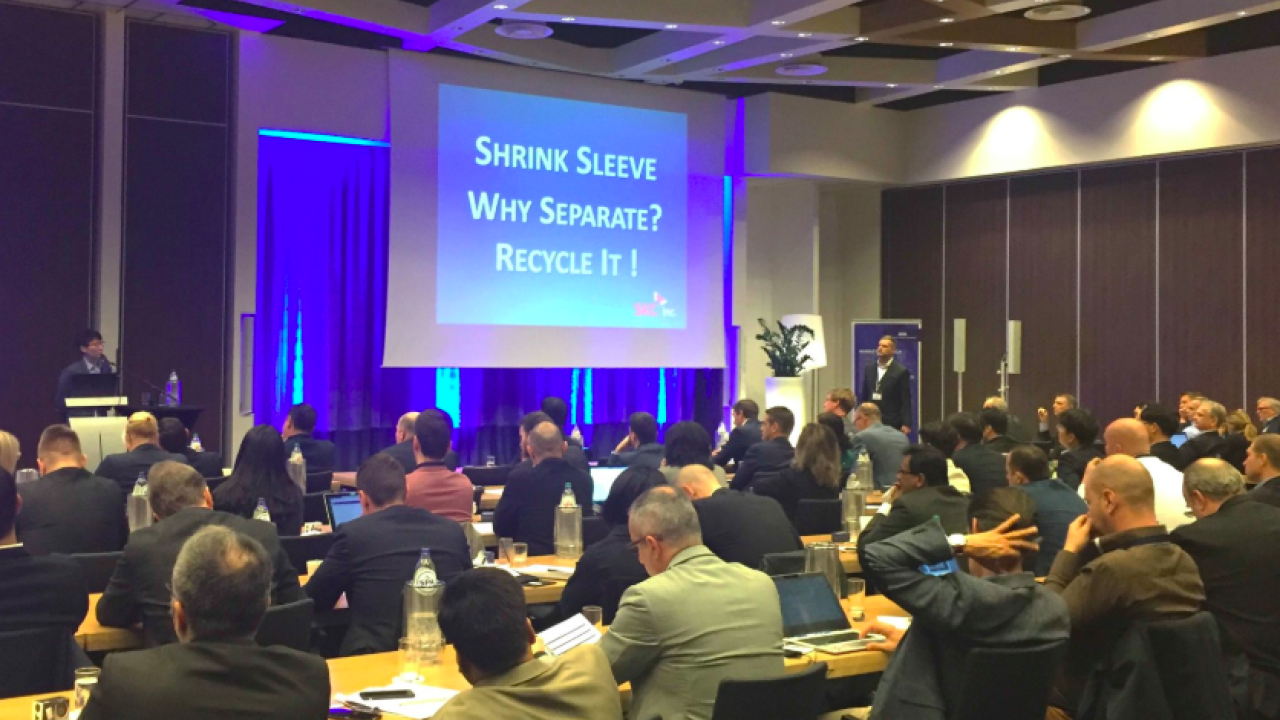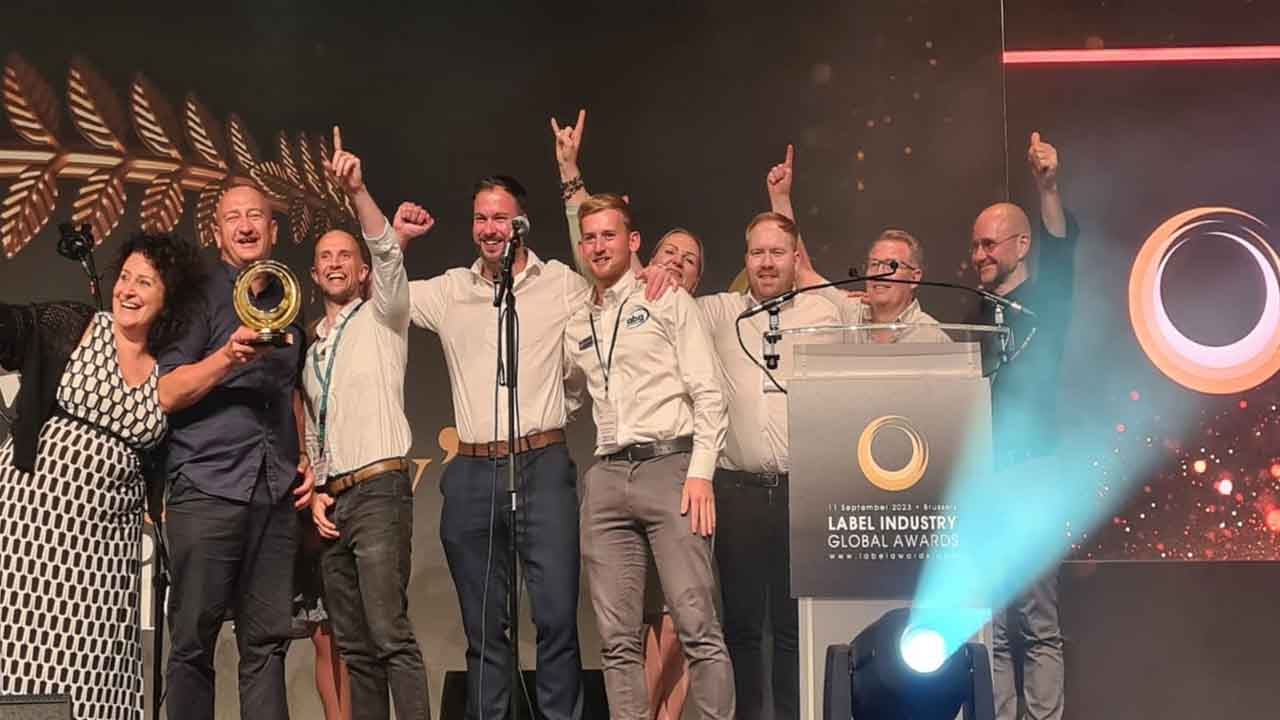AWA dives deep into sleeves

This year’s AWA International Sleeve Label Conference and Exhibition addressed a number of important issues affecting the market. Taking place in Amsterdam in early April, the event brought together over 120 delegates for the two-day agenda, representing the value chain for sleeve labeling.
Market profile
AWA president and CEO Corey Reardon’s opening presentation provided a review of the overall labeling and packaging market, highlighting where sleeving fits in. The data he presented revealed that today it represents 19 percent of the total global label market, and that it holds an equal share, based on square meter volume of material used, of the primary product labeling market as that for pressuresensitive labels. Sleeve labels will enjoy a continuing healthy growth rate of 5.4 percent a year, Reardon added.
As such, his presentation effectively set sleeving in the context of growth trends across the full packaging and labeling market, from pressure-sensitive labels to flexible packaging, folding cartons, and direct-to-container print, as well as M&A activity and industry consolidation.
Within sleeving, the outright winner in terms of volume, growth and popularity with brand owners is heat shrink TD sleeving. It enjoys an 89 percent share of the global sleeving market and is, of course, a popular choice today in the beverage segment.
Reardon was followed by Jörg Schönwald, president of Schönwald Consulting, who explored the ongoing success of flexible packaging in the European market and the challenges it faces. Shrink sleeves are often seen as the bridge between labels and flexible packaging, given the materials and applications.
On materials, Schönwald noted this includes a ‘huge variety of laminates’ which can be a problem in many ways, both for production and the environment. In terms of 2018 overall flexible packaging volumes, usage was centered on the food, pet food and beverage sectors, which together took 86 percent of the overall market. Schönwald underlined the possibilities for finding material solutions in the circular economy for flexible packaging, some of which are already available and include paper. He also cited bioplastics, which are projected to grow by 25 percent over the next five years, but which represent a tiny 1.5 percent of flexible packaging’s substrate consumption in Europe today.
Case studies
The program then moved on to real-world success stories with sleeve labeling. Pernod Ricard production specialist Lucas Helferty informed the audience that his company uses shrink sleeves to maintain a premium brand position. Pernod Ricard purchases around 11 million shrink sleeves per year. Malibu rum, he explained, has benefitted from shrink sleeves in different manifestations for a number of years. Shrink sleeves are the company’s choice for a number of reasons, Helferty explained, offering 360-degree decoration, with more flexibility to place design features and print mandatory information; the ability to print high-detail design elements; and – importantly – consistent, high-visibility shelf standout. Pernod Ricard has also explored the use of NFC and augmented reality to drive consumer engagement and insights. This has been realized with a tag applied to the inside of the Malibu sleeve.
A special version of the product’s packaging with this feature has already been launched in Germany and the UK and will arrive in the US later this year.
Erik Troost, retail and trade marketing manager for L’Oréal’s Professional Products division, went on to detail a consumercentric approach to brand evolution and product life-cycle impact. He explained that, today, the brand owner’s agenda for designing, producing and selling products is different from the traditional view of the market, which identifies four age categories, four income categories, two gender categories and four race/ ethnicity categories. Today, the market is an ‘omnichannel’, as Troost described it, with just a single tribe with common values and whose prime influences are social media and other online manipulators. In addition to this new marketing agenda, brand owners need to innovate in their choice of ingredients, manufacturing processes and, of course, packaging to ensure that they are sustainable. This is a broad challenge, but one to which L’Oréal is committed and already actively pursuing, offering refillable bottles, a shower-safe paper bottle, and using recycled and recyclable plastics.
Helferty from Pernod Ricard was uncompromising in his view of the future for sleeving. He urged brand owners to ‘continue to think big, and challenge converters and their suppliers to create solutions for your ideas.’ Film and resin suppliers, ink suppliers, and equipment manufacturers should aim to provide better performance without compromising current standards and deliver good environmental sustainability.
Sleeves and recycling
A conference session devoted to sustainability issues was opened by Vincent Mooij, head of Suez Circpack, who addressed how sleeves corrupt recycling.
Suez Circpack is a new service for brand owners and packaging producers to help improve the recyclability of their packaging from global resource management company Suez. Mooij noted that the design focus of sleeves has been centered on marketing factors and reduced-cost production, and this has created problems in recycling processes – for example with NIR identification of sleeves versus bottles in sorting, and in mixed recycling with PET bottles and perforated sleeves. Mooij provided a useful set of design guidelines for PET bottles and their labels and sleeves, in the context of the requirements of the European Packaging Regulations, and urged the audience to ‘co-create the design for recycling – and let’s co-create new recycling technologies.’ His suggestions included chemical recycling, robotization and AI, image recognition technology and watermarking.
Recycling was also addressed by Will Schretzman, vice president of packaging for Verst Group Logistics, an international provider of warehousing, transportation and contract packaging services. ‘Get in sync with recycled shrink’ was his subject. Perforated sleeves, which consumers can easily separate from plastic containers after use to make recycling less complicated are, he said, contributing positively to the recycling agenda. However, he underlined: ‘No single solution addresses all issues. We must increase the availability and quality of recycled materials, reduce the confusion surrounding the recyclability of packaging components, and improve the reliability of recyclability claims.’
Substrates, print, application
The technologies that are key to the successful creation of sleeve labels were of course a key part of the conference agenda, including substrates and print. SKC’s innovative APR-approved clear PET heatshrinkable EcoLabel fully-recyclable sleeve label film, printed with washable inks was highlighted, as were Flint Group Narrow Web’s new-generation inks, designed and tested to deliver the required performance for shrink sleeves. Troubleshooting seaming technology and solvent for seaming with Karlville’s new third generation machines – officially launching at Labelexpo Europe 2019 – was featured; and ‘doing more with less’ was one of the key benefits highlighted for using Sleeve Technology’s autosplicer for sleeve film webs, which delivers high-speed automatic reel splicing and changing.
The print technologies themselves were also featured. Gallus detailed what printers need to know when printing monofilm sleeves, and HP Indigo examined the business of when shrink sleeves go digital.
International Sleeve Label Awards
The winners of AWA’s International Sleeve Label Awards were announced at the Amsterdam event, chosen by a judging panel consisting of Séamus Lafferty, president, Accraply; Pär Olsson, technical manager, Nordic and Baltic Narrow Web at Flint Group; and AWA consultant Dr William Llewellyn.
Corey Reardon, president and CEO of AWA, said: ‘This year’s winners are examples of the diversity of solutions that can be achieved by skilled converters with the different sleeving technologies, container types, and today’s printing processes.’
The award for heat shrink TD sleeves was given to Belgium-based Reynders Etiketten for its Peachtree Peach Liqueur bottle labels for De Kuyper Royal Distillers, which the judges described as ‘flawless’. Printed UV flexo on 50 micron PET, spot varnished, and inside-printed with cold foil, the sleeves were perfectly applied to the full length of the bottle, and represent a fine example of quality product branding.
Another popular application for sleeve labels – cans – delivered a deserving award winner: UK-based Berkshire Labels, for its elegant sleeves on Titsey Brewing Company’s Innes Lager. They were digitally printed on 45 micron PET, with excellent tactile embellishments.
A third award was given to CCL Label in Austria for a sleeve label delivering a notable environmental innovation – for the stretch sleeves on supermarket giant Albert Heijn’s bio-based PE milk container. It carries the first-ever bio-based stretch sleeve, made from sugar cane biopolymer, and printed flexo. Edmondo Motto from CCL Label collected the award.
The judges were also impressed with other entries in the heavilysupported heat shrink TD sleeves category. In addition to Reynders Etiketten’s award, they conferred honorable mentions on three other submissions: CCL Label Sleeve Solutions’ label for Procter & Gamble’s Lenor Blush Parfum des Secrets fabric conditioner, and also for labels on Dum Dum isotonic drinks for Bibita Beverages; and US converter McDowell Label for labels on Australian Gold JWOWW toning bronzer. McDowell Label also gained an honorable mention in the sleeved cans category for its label for Cellucor C4 sports drinks.
Reviewing the judging as a whole, Séamus Lafferty commented: ‘With a record number of entrants this year – and an even broader global reach than previously – it is clear that the shrink sleeve label format continues to prove its worth on retail shelves around the world. Innovation in shape, graphic appeal, and the overall improved focus on quality was very clearly evident in the competition this year, all of which bode very well for the continued growth of shrink sleeves, and all of which should make this year’s winners very proud.’
Stay up to date
Subscribe to the free Label News newsletter and receive the latest content every week. We'll never share your email address.

